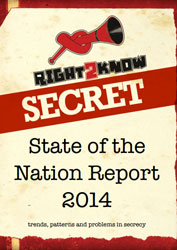Right2Know Campaign – Mapping SA’s (Growing?) Climate Of Secrecy
 Twenty years into South Africa’s democracy, the right to know faces apparent threats.
Twenty years into South Africa’s democracy, the right to know faces apparent threats.
The right to know – to access and share information, to organise, protest and speak out – is the foundation of a just society. Information rights were a driving principle in the struggle against apartheid, and at the centre of the democratic gains achieved in the 1990s.
Twenty years into South Africa’s democracy, these gains appear to be facing greater limits.
Climate of secrecy
At the heart of this is an emerging trend towards security-statist approaches to governance.[i] An expansive ‘national security’ mentality encroaches on democratic principles by stifling debate,undermining accountability and protecting the powerful from scrutiny.
The best-known embodiment of this securitystatist mentality is the Protection of State Information Bill (the Secrecy Bill), which sits on President Zuma’s desk, awaiting signature. Few laws have so focused the public mind on the problem of secrecy in our society and what appears to be a resurgence of the ‘securocrats’.
But the Bill may merely be a symptom of a broader climate of secrecy and securitisation:
– The use of secrecy to shield political actors, in particular President Zuma, from embarrassment and accountability;
– Increasing limitations on protest, with an extraordinary spike in police violence and growing signs of criminalisation of protest;
– Apparent increase in the use of state-security policies such as the National Key Points Act;
– Lack of democratic oversight of surveillance tools which are vulnerable to abuse.
Ordinary people, ordinary secrets
Secrecy is not only about the political machinations of major institutions. At the heart of possibly every grassroots struggle for social, economic or environmental justice, there is a need for information. This is often basic information about bread-and-butter issues, which people need in order to exercise control over their own lives. Here we see worrying signs of the obstacles to accessing information:
– Access to information mechanisms are failing;
– There is too little proactive release of information;
– The transparency obligations of the private sector, particularly in industries with a serious environmental impact, are largely overlooked. Read more
BBC Documentary ~ The History Of Racism
Reaching back across the centuries, this program sheds light on historical attitudes toward human differences. It assesses the significance of Biblical narratives, including the curse of Ham, in the evolution of European concepts of race, and goes on to examine the basis of institutionalized racism—entwined with fervent capitalism—on which the transatlantic slave trade operated. The destruction of Americas indigenous civilizations and the dehumanization and exploitation of Africans are studied alongside the writings of Enlightenment philosophers and historians. Experts interviewed include Dr. Orlando Patterson of Harvard University, Dr. Barnor Hesse of Northwestern, and Professor James Walvin of the University of York.
New York Times ~ Forum For New Diplomacy – Marlise Simons In Conversation With Fatou Bensouda (ICC)
Fatou Bensouda, chief prosecutor for the International Criminal Court, in conversation with Marlise Simons, correspondent for The New York Times
Pierre-Dominique Gaisseau – Sur la carte du monde: une tache blanche en moins…
Interview de Pierre-Dominique Gaisseau, à propos de sa récente traversée de la Nouvelle Guinée, région du monde jusque-là inexplorée. Il raconte l’expédition en commentant les images qu’il en a rapporté.
ISSA Proceedings 2006 ~ From Figure To Argument: Contrarium In Roman Rhetoric
 1. Introduction
1. Introduction
Roman rhetoricians knew about a certain rhetorical device called contrarium, which they, however, variably considered either a figure of speech or a certain type of argument, at times even both. This paper will try to analyze the function of this term that vacillates between the realms of stylistic embellishment and argumentation and to elucidate both its logical background and linguistic appearance. In a first section, the development of the concept of contrarium from the Rhetoric to Herennius to Cicero and Quintilian will be sketched. Next, Cicero’s account of the enthymeme in his Topics and its relationship to contrarium will be analyzed and, based on the examples offered by those authors, an analysis of the typical pattern of this type of argument will be given. A study of a selection of examples from Cicero’s writings will reveal their underlying argumentative basis, before finally the persuasive force of the standard phrasing as rhetorical questions will be discussed.
2. Contrarium in Roman Rhetoric
2.1. Contrarium in the Rhetoric to Herennius
In the fourth book of the anonymous Rhetoric to Herennius, which is arguably the oldest extant rhetorical handbook in Latin, most commonly dated to the mid-80s of the first century B.C.E., a feature called contrarium appears within a lengthy list of figures of diction (Rhet. ad Her. 4.25-26). It is defined as a figure “which, of two opposite statements, uses one so as neatly and directly to prove the other.” Unfortunately, the anonymous author does not go into any greater analytic detail. Instead, he prefers to offer a whole series of examples, as follows (trans. Caplan 1954, p. 293, modified):
(1) Now how should you expect one who has ever been hostile to his own interests to be friendly to another’s?
(2) Now why should you think that one who is, as you have learned, a faithless friend, can be an honourable enemy?
(3) How should you expect a person whose arrogance has been insufferable in private life, to be agreeable and self-knowing when in power, and
(4) one who in conversation among friends has never spoken the truth, to refrain from lies before public assemblies?
(5) Do we fear to fight them on the plains when we have hurled them down from the hills?
(6) When they outnumbered us, they were not equal to us; now that we outnumber them, do we fear that they will be superior to us?
It is obvious that in each of these examples one or more pairs of opposites are involved:
(1) own interests versus another’s; hostile versus friendly;
(2) friend versus enemy;
(3) arrogance versus agreeability; private life versus position in power;
(4) truth versus lies; conversation among friends versus public assemblies;
(5) plains versus hills;
(6) them outnumbering us versus us outnumbering them; not even equal versus superior. Read more
Fatsoenlijk land ~ Proloog – Verzet in twee werelden
 De negentienjarige Bob van Amerongen aarzelde niet toen hij het in het voorjaar van 1943 het verzoek kreeg om voor een collega van zijn vader een onderduikadres te zoeken. Voor hem was het vanzelfsprekend mensen te helpen. Tante Louise had direct hulp nodig.
De negentienjarige Bob van Amerongen aarzelde niet toen hij het in het voorjaar van 1943 het verzoek kreeg om voor een collega van zijn vader een onderduikadres te zoeken. Voor hem was het vanzelfsprekend mensen te helpen. Tante Louise had direct hulp nodig.
Zoals voor iedereen die zich bezighield met dergelijke activiteiten was het een riskante onderneming. Als kind uit een gemengd huwelijk waren de risico’s voor Bob nog groter. Als hij door de Duitsers gepakt zou worden, vreesde Bob, liep hij de kans er een extra joodse grootouder bij te krijgen en zo van ‘half-jood’ tot ‘voljood’ te promoveren. Met als zekerheid een enkele reis naar het vernietigingskamp.
Vanaf begin 1943 gaf Bob van Amerongen samen met Jan Hemelrijk leiding aan een groep ‘illegalici’, gespecialiseerd in hulp aan joodse onderduikers. Net als Bob kwam ook Jan Hemelrijk uit een gemengd huwelijk: allebei hadden ze een joodse vader en een niet-joodse moeder. Beide jongemannen leefden in feite in twee werelden.
Enerzijds gaven ze leiding aan een verzorgingsgroep. Anderzijds waren ze verwant aan hun onderduikers. Hun familieleden en vrienden waren immers de eersten die beroep op hen deden. Naarmate de oorlog vorderde, werd de groep steeds groter en ontwikkelde zij zich tot een netwerkorganisatie met verschillende afdelingen.
Jan Hemelrijk gaf de groep de naam PP-groep. Dat gebeurde bij de oprichting van de Vrije Groepen Amsterdam (VGA) in 1944 toen elke groep een naam moest kiezen. Je zou kunnen denken dat het een verwijzing is naar Potasch en Perlemoer, de twee kibbelende joodse zakenlieden uit de bekende gelijknamige vooroorlogse volkskomedie. Maar dat was niet het geval. Jan liet zich inspireren door de ‘porgel’ en de ‘porulan’, fantasiebeesten in het clandestien verschenen nonsensrijm De Blauwbilgorgel (1943) van Cees Buddingh’. Jan kortte de namen simpelweg af zoals zoveel verzetsgroepen deden.
Aan het eind van de oorlog bestond de PP-groep uit 19 kernleden, onder wie oud-leerlingen van het Murmellius Gymnasium (Alkmaar), de school van Bob en Jan, en het Vossius Gymnasium (Amsterdam). Ze redden waarschijnlijk enkele tientallen joden het leven.
Alleen Bob verzorgde al zeventien onderduikers. Niet alleen familieleden en vrienden uit eigen kring, maar ook mensen van buitenaf. Onder hen waren mijn moeder Miep Gompes-Lobatto, mijn oom Jaap Lobatto en hun nichtje Betty de Vries.
De gesprekken die ik tien jaar geleden met Bob van Amerongen en Jan Hemelrijk had, maakten grote indruk op me. Ze spraken over de oorlog alsof deze gisteren had plaatsgevonden. De gebeurtenissen van toen hadden hen duidelijk nooit meer losgelaten.
Bob had er nog steeds last van dat hij bepaalde mensen niet op tijd had kunnen onderbrengen. Ook gaf hij aan hoe ongelooflijk moeilijk het was geweest voor joden onderduikadressen te vinden.
Jan zat het nog steeds dwars dat zijn vader gepakt was door verraad. Hij had nog wel zo’n uitstekend persoonsbewijs voor hem gemaakt. Ondanks de voortdurende stress tijdens de oorlog had Jan geen spijt van zijn verzetsactiviteiten. Hij had niet als zovele anderen langs de zijlijn willen blijven staan.
De PP-groep voor het voetlicht brengen, lijkt me van belang. Niet alleen om Bob van Amerongen en Jan Hemelrijk de aandacht te geven die ze verdienen, maar ook omdat in Nederland het verzorgingsverzet onderbelicht is gebleven. Publicaties hierover zijn schaars. In verzetsfilms gaat het vaak over het gewapende verzet, zoals in Soldaat van Oranje en Het meisje met het rode haar. Bij het verzorgingsverzet ging het vaak om minder opzienbarende, maar daarom niet onbelangrijkere handelingen. Read more


